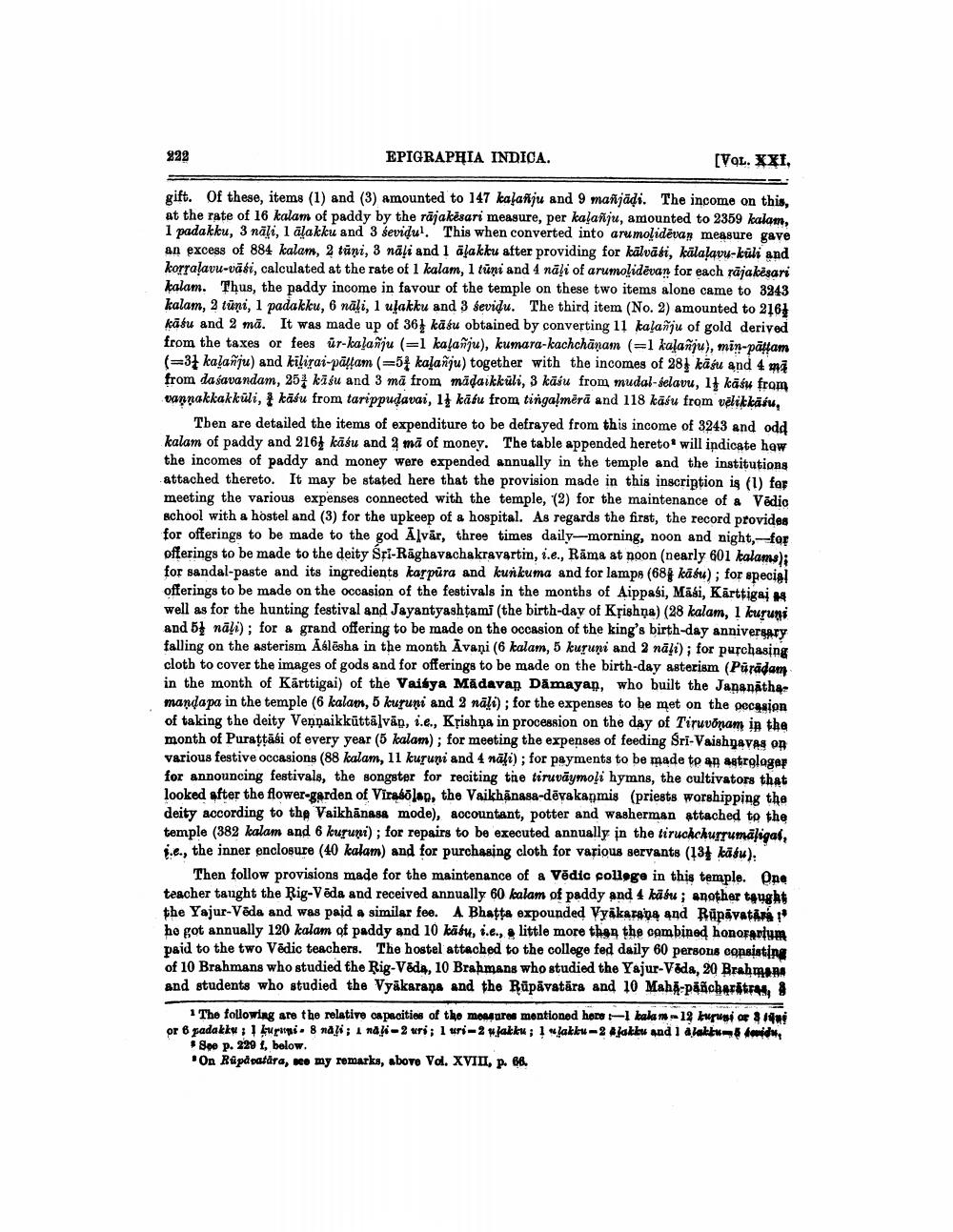________________
222
EPIGRAPHIA INDICA.
[VOL. XXI,
gift. Of these, items (1) and (3) amounted to 147 kalasju and 9 mañjādi. The income on this, at the rate of 16 kalam of paddy by the rājakësari measure, per kalañju, amounted to 2359 kalam, 1 padakku, 3 nāļi, 1 āļakku and 3 sevidul. This when converted into arumolidēvan measure gave an excess of 884 kalan, 2 tāni, 3 nāļi and 1 alakku after providing for kālvāti, kālalavu-küli and korralavu-vāsi, calculated at the rate of 1 kalam, 1 tūni and 4 nāļi of arumolidēvan for each rājakesari kalam. Thus, the paddy income in favour of the temple on these two items alone came to 3243 kalam, 2 tūni, 1 padakku, 6 nāli, 1 ulakku and 3 sevidu. The third item (No. 2) amounted to 2161 kāśu and 2 mā. It was made up of 364 kašu obtained by converting 11 kalanju of gold derived from the taxes or fees ur-kalanju (=1 kalanju), kumara-kachchānam (=1 kalanju), min-pāttam (=37 kalanju) and kilirai-pāļtam (=54 kalanju) together with the incomes of 281 kāśu and 4 ma from daśavandam, 254 kafu and 3 mă from mādaikküli, 3 kāíu from mudal-selavu, 14 kāśu from vannakkakkūli, i kāśu from tarippudavai, it kābu from tingaļmērā and 118 kāfu from vēlikkāśu,
Then are detailed the items of expenditure to be defrayed from this income of 3243 and odd kalam of paddy and 2161 kāśu and 2 mă of money. The table appended hereto will indicate how the incomes of paddy and money were expended annually in the temple and the institutions attached thereto. It may be stated here that the provision made in this inscription is (1) for meeting the various expenses connected with the temple, (2) for the maintenance of a Vēdio school with a hostel and (3) for the upkeep of a hospital. As regards the first, the record provides for offerings to be made to the god Alvār, three times daily-morning, noon and night, for offerings to be made to the deity Sri-Rāghavachakravartin, i.e., Rāma at noon (nearly 601 kalams); for sandal-paste and its ingredients karpūra and kurkuma and for lamps (68 käsu); for special offerings to be made on the occasion of the festivals in the months of Aippasi, Māsi, Kärttigai 14 well as for the hunting festival and Jayantyashtami (the birth-day of Kșishņa) (28 kalam, 1 kuruni and 51 nāļi); for a grand offering to be made on the occasion of the king's birth-day anniversary falling on the asterism Aslēsha in the month Avaņi (6 kalam, 5 kuruni and 2 nāļi); for purchasing cloth to cover the images of gods and for offerings to be made on the birth-day asterism (Puradam in the month of Kärttigai) of the Vaisya Mādavan Dāmayan, who built the Jananātha mandapa in the temple (6 kalan, 5 kuruni and 2 nāļi); for the expenses to be met on the pecesion of taking the deity Vennaikküttā]vān, i.e., Kșishna in procession on the day of Tiruvonam in the month of Purattasi of every year (5 kalam); for meeting the expenses of feeding Sri-Vaishnavas on various festive occasions (88 kalam, 11 kuruni and 4 nāļi); for payments to be made to an astrologer for announcing festivals, the songster for reciting the tiruvāymoli hymns, the cultivators that looked after the flower-garden of Virabolap, the Vaikhānasa-dēvakanmis (priests worshipping the deity according to the Vaikhānasa mode), accountant, potter and washerman attached to the temple (382 kalam and 6 kuruni); for repairs to be executed annually in the tiruchchurrumāļigai, j.e., the inner enclosure (40 kalam) and for purchasing cloth for various servants (131 käsu).
Then follow provisions made for the maintenance of a Vidic college in this temple. One teacher taught the Rig-Vēda and received annually 60 kalam of paddy and 4 kafu ; another tought the Yajur Veda and was paid a similar fee. A Bhatta expounded Vyakarane and Rūpävatis !! he got annually 120 kalam of paddy and 10 kābu, i.e., little more then the combined honorarium paid to the two Vēdic teachers. The hostel attached to the college fed daily 60 persons consisting of 10 Brahmans who studied the Rig Veda, 10 Brahmans who studied the Yajur-Vada, 20 Brahmans and students who studied the Vyakarana and the Rūpāvatāra and 10 Mahā-pañchartre,
1 The following are the relative capacities of the measures mentioned horo - balan - 19 kuusi or 314 or 6 padakku : 1 kurumi8 nali ; 1 naji - 2 uri; 1 uri-2 Jakku ; ! Jakku-2 Jakku and i dlaktum ferida
# Soe p. 229 I, below.
On Rüpdrafdra, so my remarks, abovo Vol. XVIII, p. 66.




